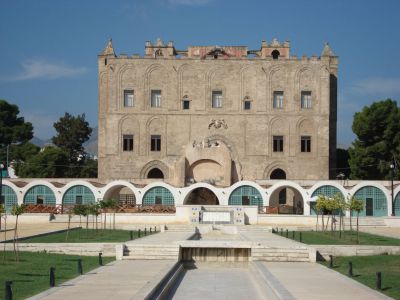Castello della Zisa (Zisa Castle), Palermo
The Zisa Castle (Castello della Zisa), situated in the western part of Palermo, is a significant architectural relic from the 12th century, reflecting the cultural synthesis of Norman and Arab craftsmanship under the reign of the Norman kings. The construction of this grand hunting lodge and summer palace began around 1165, initiated by Arab craftsmen under the rule of King William I of Sicily and completed in 1189 during the rule of his successor, William II. Its name, "Zisa," comes from the Arabic term al-Azīz, meaning "dear" or "splendid," emphasizing its grandeur.
The Zisa Castle, originally part of the "Earthly Paradise" royal hunting estate alongside Cuba Sottana, Cuba Soprana, and Uscibene palace, was surrounded by vast gardens, now lost. By the 15th century, the Zisa had deteriorated and changed ownership multiple times. In 1635, Giovanni de Sandoval, a relative of the Sicilian Viceroy, acquired it, and it remained privately owned until the early 19th century. Significant decline by the 1950s led to restorations starting in the 1990s by the Region of Sicily, culminating in its 2015 designation as a UNESCO World Heritage Site, part of the Arab-Norman Palermo and the Cathedral Churches of Cefalù and Monreale.
Architecturally, the Zisa is distinguished by its Islamic design elements such as muqarnas and vaulted niches. The original structure has undergone several modifications over the centuries, including the addition of merlons in the 14th century and major renovations in the 17th century by Giovanni di Sandoval e Platamone, who added new rooms and external windows. Notably, the castle's design includes an innovative air conditioning system, inspired by ancient Egyptian and Mesopotamian techniques, which allowed airflow throughout the building, a testament to the ingenuity of its architects.
Today, the Zisa Castle is open to the public, offering a glimpse into the rich cultural and historical tapestry of Sicily during the Norman rule. Visitors can explore the restored palace and appreciate both its historical significance and its architectural beauty.
The Zisa Castle, originally part of the "Earthly Paradise" royal hunting estate alongside Cuba Sottana, Cuba Soprana, and Uscibene palace, was surrounded by vast gardens, now lost. By the 15th century, the Zisa had deteriorated and changed ownership multiple times. In 1635, Giovanni de Sandoval, a relative of the Sicilian Viceroy, acquired it, and it remained privately owned until the early 19th century. Significant decline by the 1950s led to restorations starting in the 1990s by the Region of Sicily, culminating in its 2015 designation as a UNESCO World Heritage Site, part of the Arab-Norman Palermo and the Cathedral Churches of Cefalù and Monreale.
Architecturally, the Zisa is distinguished by its Islamic design elements such as muqarnas and vaulted niches. The original structure has undergone several modifications over the centuries, including the addition of merlons in the 14th century and major renovations in the 17th century by Giovanni di Sandoval e Platamone, who added new rooms and external windows. Notably, the castle's design includes an innovative air conditioning system, inspired by ancient Egyptian and Mesopotamian techniques, which allowed airflow throughout the building, a testament to the ingenuity of its architects.
Today, the Zisa Castle is open to the public, offering a glimpse into the rich cultural and historical tapestry of Sicily during the Norman rule. Visitors can explore the restored palace and appreciate both its historical significance and its architectural beauty.
Want to visit this sight? Check out these Self-Guided Walking Tours in Palermo. Alternatively, you can download the mobile app "GPSmyCity: Walks in 1K+ Cities" from Apple App Store or Google Play Store. The app turns your mobile device to a personal tour guide and it works offline, so no data plan is needed when traveling abroad.
Castello della Zisa (Zisa Castle) on Map
Sight Name: Castello della Zisa (Zisa Castle)
Sight Location: Palermo, Italy (See walking tours in Palermo)
Sight Type: Attraction/Landmark
Sight Location: Palermo, Italy (See walking tours in Palermo)
Sight Type: Attraction/Landmark
Walking Tours in Palermo, Italy
Create Your Own Walk in Palermo
Creating your own self-guided walk in Palermo is easy and fun. Choose the city attractions that you want to see and a walk route map will be created just for you. You can even set your hotel as the start point of the walk.
Palermo Introduction Walking Tour
Around 8,000 BC, people called Sicani drew pictures in a cave outside Palermo. The scene shows a ritual sacrifice in the theatre. Was it a paleolithic foreshadowing of the temples, churches, and cathedrals to come?
The Sicani were succeeded by the Phoenicians. They made a settlement called Ziz which eventually became Palermo. But first, the Greeks, followed by the Carthaginians, followed by the... view more
Tour Duration: 2 Hour(s)
Travel Distance: 3.1 Km or 1.9 Miles
The Sicani were succeeded by the Phoenicians. They made a settlement called Ziz which eventually became Palermo. But first, the Greeks, followed by the Carthaginians, followed by the... view more
Tour Duration: 2 Hour(s)
Travel Distance: 3.1 Km or 1.9 Miles
Palaces of Palermo
For centuries, Sicilian capital Palermo has been a focal point for the construction of noble dwellings and palaces. The latter were and still are a fine manifestation of the historical life in the region. They are a few hundred of them still in place, ranging chronologically from the medieval period to the first decades of the 20th century, and comprising an impressive collection of architectural... view more
Tour Duration: 1 Hour(s)
Travel Distance: 2.6 Km or 1.6 Miles
Tour Duration: 1 Hour(s)
Travel Distance: 2.6 Km or 1.6 Miles
Historical Religious Buildings
Religion has always played an important role in the lives of the Italians – and the Sicilians are no exception. Thus, it is little wonder that the main city of the island, Palermo, boasts a plethora of religious buildings. The collection of historical churches found here ranges from the Arab-Norman-Byzantine to the Medieval, Gothic, Baroque and the Renaissance.
In the course of history, many... view more
Tour Duration: 2 Hour(s)
Travel Distance: 3.2 Km or 2 Miles
In the course of history, many... view more
Tour Duration: 2 Hour(s)
Travel Distance: 3.2 Km or 2 Miles






